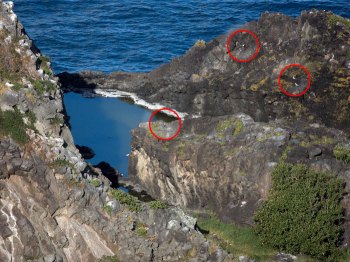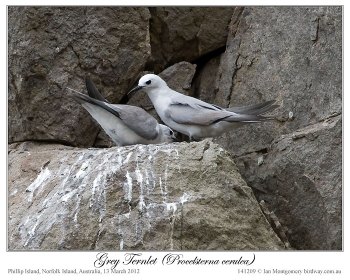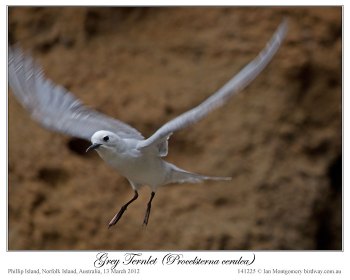Last week we had the (Common) White Tern or White Noddy. Here is its counterpart the Grey Ternlet, often called the Grey Noddy. It is also an island species but is restricted in range to the Western and South Pacific. In the Australian regions it, like the White Tern, occurs on both Lord Howe and Norfolk Islands. Unlike the White Tern, it nests mainly on inaccessible rock cliffs and I had had only distant views of it on Lord Howe 20 years ago. The situation was similar on Norfolk Island, and the first photo, taken at Captain Cook’s Lookout, was our first view of any. This photo, I might add, was taken with a 500mm telephoto lens, so we were nowhere near them.

Grey Noddy (Procelsterna albivitta) by Ian 1
So we hoped that our planned boat trip to nearby Phillip Island would provide better views and photo opportunities. It was late in the nesting season, though, and when we returned to the rocky cove to be picked up by the boat, we still hadn’t seen any, even in the distance. Getting on and off the boat was an interesting exercise as there is no wharf, just a north-facing cove, sheltered in southerly winds and swell, with a slippery rock shelf, best negotiated in stockinged feet for better traction, second photo (that’s Norfolk Island in the background).

Grey Noddy (Procelsterna albivitta) by Ian 2
We were just getting ready to board the approaching boat, when two Grey Ternlets landed on a rocky cliff nearby, and the boat was forgotten while I dug the camera out of my backpack. The two birds were an adult and a juvenile, the adult standing over the juvenile, which has dark markings on the head, in the third photo.

Grey Noddy (Procelsterna albivitta) by Ian 3
I moved closer to them, but the adult flew off, leaving the youngster to its fate, fourth photo.

Grey Noddy (Procelsterna albivitta) by Ian 4
The adult had landed almost out of sight behind a rocky outcrop, but I got a photo of it when it took off a little later, fifth photo.

Grey Noddy (Procelsterna albivitta) by Ian 5
Anyway, it was time to leave the Ternlets to their own devices and get on the boat. We were to see more Grey Ternlets on the cliffs of Norfolk Island, including a flock of about 15, but we never got close to them again. It was a great ending to a very successful trip to Phillip Island and we didn’t mind too much getting rather wet from the spray on the way back to Norfolk Island, the cameras being safety stowed in a dry spot.
Best wishes
Ian
**************************************************
Ian Montgomery, Birdway Pty Ltd,
454 Forestry Road, Bluewater, Qld 4818
Tel 0411 602 737
ian@birdway.com.au
Check the latest website updates:
http://www.birdway.com.au/#updates
**************************************************
Lee’s Addition:
What scenery and what a beautiful Noddy. These Noddies or Ternlets like to nest on protected cliffs it appears.
The place where you live is safe. Your nest is on a high cliff. (Numbers 24:21a NIrV)
The Grey Noddy or Grey Ternlet (Procelsterna albivitta) is a seabird belonging to the tern family Laridae. It was once regarded as a pale morph of the Blue Noddy (Procelsterna cerulea) but is now often considered to be a separate species. It occurs in subtropical and warm temperate waters of the south Pacific Ocean.
It is 25–30 cm (9.8–12 in) long with a wingspan of 46–61 cm (18–24 in) and a weight of about 75 grams (2.6 oz). The tail is fairly long and notched. The plumage is pale grey, almost white on the head and underparts but darker on the back, tail and wings. The wings have dark tips and a white hind edge and are mainly white underneath. The eye is black and appears large due to the black patch in front of it. There is a white patch behind the eye. The thin, pointed bill is black and the legs and feet are also black apart from pale yellow webs.
It feeds in shallow water, not moving far from the breeding colonies. It gathers in large feeding flocks which can contain thousands of individuals. They feed by hovering over the water and dropping down to pick food from the surface. Plankton forms the bulk of the diet and small fish are also eaten.
Breeding takes place in colonies on rocky islands. The nest site is a sheltered rocky surface or underneath a boulder or clump of vegetation. A single egg is laid. Juvenile birds are browner than the adults and have darker, more contrasting flight feathers.
The Grey Noddy is usually silent but has a soft, purring call.
(The verse is out of context, but the nest on the cliff fit with these birds. Wikipedia cited.)
See Also:
Bird of the Week – by Ian
Birdway’s Laridae Family
Laridae – Gulls, Terns and Skimmers
Grey Noddy – Wikipedia
*




